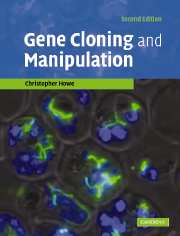Book contents
- Frontmatter
- Contents
- Preface to first edition
- Preface to second edition
- Chapter 1 The tools for the job
- Chapter 2 Polymerase chain reaction
- Chapter 3 Simple cloning
- Chapter 4 Other vector systems for E. coli
- Chapter 5 Making libraries
- Chapter 6 Screening libraries
- Chapter 7 Modification and mutagenesis
- Chapter 8 Use of cloned DNA
- Chapter 9 Using other organisms
- Chapter 10 Examples
- References
- Index
Chapter 6 - Screening libraries
Published online by Cambridge University Press: 05 June 2012
- Frontmatter
- Contents
- Preface to first edition
- Preface to second edition
- Chapter 1 The tools for the job
- Chapter 2 Polymerase chain reaction
- Chapter 3 Simple cloning
- Chapter 4 Other vector systems for E. coli
- Chapter 5 Making libraries
- Chapter 6 Screening libraries
- Chapter 7 Modification and mutagenesis
- Chapter 8 Use of cloned DNA
- Chapter 9 Using other organisms
- Chapter 10 Examples
- References
- Index
Summary
Introduction
So far, we have seen how libraries can be constructed using plasmids, phages and other vectors in E. coli. But it is not enough simply to be able to clone DNA at random. It is usually necessary to go on to identify members of a library that contain a piece of DNA with particular properties. Finding those members of the library is called screening. Most often, we screen libraries for sequences with a particular coding function to find the gene or cDNA for a particular protein. There are many different strategies for doing that, and we will look at those first. Sometimes libraries are screened for DNA with a particular function other than for coding, such as the ability to initiate or terminate transcription. We will look at those techniques too.
Database screening
One of the easiest ways to find a clone for a particular sequence (usually a gene or a cDNA) is to exploit genomic analyses. For many organisms, partial or complete genome sequences are available electronically in genomic databases. There are also EST databases, which are sequences of large collections of cDNA clones, typically sequenced at random from libraries constructed from different tissue types or under different conditions. The clones used to build the genomic and EST databases are generally widely available. If such databases exist for the organism you are interested in, then it is a simple matter to search the database by computer. This kind of screening is often described as in silico.
- Type
- Chapter
- Information
- Gene Cloning and Manipulation , pp. 116 - 142Publisher: Cambridge University PressPrint publication year: 2007



